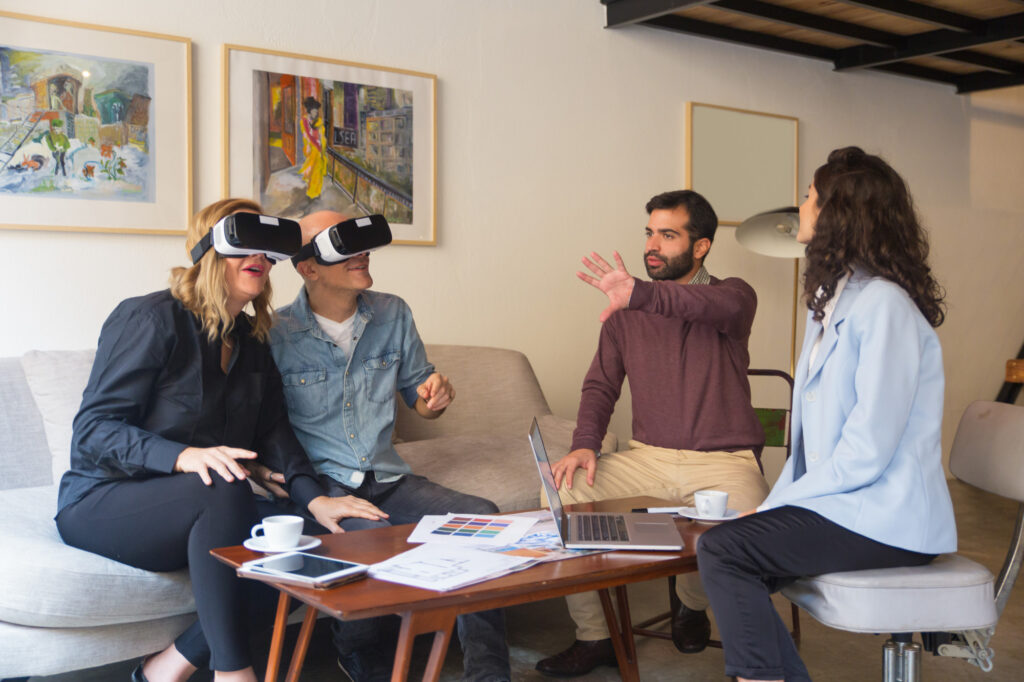In today’s rapidly evolving digital landscape, the furniture industry is experiencing a significant transformation. As consumer behaviours shift and technology advances, furniture businesses must adapt their marketing strategies to stay competitive and relevant. This comprehensive trend analysis delves into the latest digital marketing for furniture business approaches, exploring innovative techniques and emerging trends that are reshaping the industry.
The Rise of Virtual Showrooms and Augmented Reality

One of the most exciting developments in furniture store marketing is the integration of virtual showrooms and augmented reality (AR) technologies. These immersive experiences allow customers to visualise furniture pieces in their own spaces before making a purchase, significantly enhancing the online shopping experience.
- Virtual showrooms offer 360-degree views of furniture items
- AR apps enable customers to place virtual furniture in their homes
- Interactive features allow for customisation of colours and materials
This trend not only improves customer engagement but also reduces return rates, as buyers can make more informed decisions. Furniture businesses that embrace these technologies are likely to see increased conversion rates and customer satisfaction.
The Power of Social Media Influencer Partnerships
Social media continues to play a crucial role in digital marketing for your business, and influencer partnerships have become an increasingly popular strategy for furniture brands. Collaborating with interior design influencers and home decor enthusiasts can help furniture businesses reach new audiences and build credibility.
Key benefits of influencer partnerships include:
- Authentic product showcases in real-life settings
- Increased brand awareness through influencer networks
- Enhanced social proof and trust-building with potential customers
When selecting influencers, it’s essential to choose partners whose aesthetic aligns with your brand and who have engaged followers in your target market.
Content Marketing: Educate and Inspire
Creating valuable, informative content is a cornerstone of any successful furniture digital marketing strategy. By producing high-quality blog posts, videos, and infographics, furniture businesses can establish themselves as industry experts and provide value to their audience beyond just selling products.
Popular content topics in the furniture industry include:
- Interior design tips and trends
- DIY furniture upcycling projects
- Sustainable furniture materials and manufacturing processes
By addressing common pain points and offering solutions, furniture businesses can build trust with their audience and nurture long-term customer relationships.
Want Your Business to Thrive – Contact GobblexTech Marketing Agency Now!
Personalisation and AI-Driven Recommendations

As artificial intelligence (AI) and machine learning technologies advance, personalisation has become increasingly sophisticated in the e-commerce space. Furniture businesses can leverage these technologies to provide tailored product recommendations based on customer browsing history, purchase behaviour, and preferences.
Personalisation strategies may include:
- Customised email marketing campaigns
- Dynamic website content that adapts to user behaviour
- AI-powered chatbots for personalised customer service
By delivering a more relevant and personalised shopping experience, furniture businesses can improve customer satisfaction and increase conversion rates.
Video Marketing: Showcasing Products in Action
Video content has become an essential component of digital marketing for furniture business strategies. From product demonstrations to behind-the-scenes glimpses of the manufacturing process, video allows furniture brands to tell compelling stories and showcase their products in a dynamic way.
Effective video marketing ideas for furniture businesses:
- 360-degree product tours
- Customer testimonials and reviews
- Time-lapse videos of furniture assembly
- Styling tips and room makeovers
By leveraging platforms like YouTube, Instagram Reels, and TikTok, furniture businesses can engage with their audience in a more interactive and visually appealing manner.
Voice Search Optimisation
With the increasing popularity of smart speakers and voice-activated devices, optimising for voice search has become crucial for SEO services for furniture store strategies. Voice searches tend to be more conversational and question-based, requiring a shift in keyword strategies and content creation.
To optimise for voice search:
- Concentrate on long-tail keywords and phrases in natural language
- Create FAQ pages that address common customer queries
- Ensure your Google My Business listing is up-to-date and accurate
By adapting to voice search trends, furniture businesses can improve their visibility in local search results and capture customers at the early stages of their buying journey.
Sustainability and Eco-Friendly Messaging
As environmental awareness grows, consumers are increasingly seeking sustainable and eco-friendly furniture options. Incorporating sustainability messaging into your digital marketing for your business strategy can help attract environmentally conscious customers and differentiate your brand in a crowded market.
Ways to highlight sustainability in your marketing:
- Showcase eco-friendly materials and manufacturing processes
- Offer recycling or upcycling programs for old furniture
- Partner with environmental organisations or initiatives
By emphasising your commitment to sustainability, you can appeal to a growing segment of eco-conscious consumers and build brand loyalty.
User-Generated Content and Social Proof
Leveraging user-generated content (UGC) is an effective way to build trust and showcase your furniture in real-life settings. Encouraging customers to share photos of their purchases and experiences can provide authentic social proof and inspire others to make a purchase.
Strategies for incorporating UGC into your marketing:
- Create branded hashtags for customers to use when sharing photos
- Showcase customer images on your website and social media platforms
- Run contests or giveaways that encourage UGC submissions
By showcasing real customers using and enjoying your furniture, you can create a sense of community and authenticity around your brand.
Mobile-First Design and Optimisation
With an increasing number of consumers shopping on mobile devices, ensuring your website is mobile-friendly is crucial for any furniture digital marketing strategy. A mobile-first approach to web design and user experience can significantly impact your conversion rates and search engine rankings.
Key considerations for mobile optimisation:
- Design that adapts to different screen sizes
- Fast loading times and optimised images
- Easy-to-use navigation and clear call-to-action buttons
By prioritising the mobile experience, furniture businesses can capture a larger share of the growing mobile e-commerce market.
Omnichannel Marketing and Seamless Customer Experience
Creating a seamless experience across all customer touchpoints is essential for modern furniture store marketing. An omnichannel approach ensures that customers receive consistent messaging and a unified brand experience whether they’re shopping online, in-store, or through social media.
Elements of an effective omnichannel strategy:
- Uniform branding and messaging on every platform
- Integration of online and offline customer data
- Click-and-collect or ship-to-store options
By providing a cohesive customer journey, furniture businesses can increase customer satisfaction and foster brand loyalty.
Data-Driven Decision Making and Analytics
Leveraging data and analytics is crucial for optimising your digital marketing for furniture business efforts. By tracking key performance indicators (KPIs) and analysing customer behaviour, furniture businesses can make informed decisions and continually refine their marketing strategies.
Important metrics to monitor include:
- Website traffic and conversion rates
- Customer acquisition costs
- Email open and click-through rates
- Social media engagement and reach
Regular analysis of these metrics can help identify areas for improvement and ensure that your marketing efforts are delivering a strong return on investment.
Conclusion: Embracing the Future of Furniture Marketing
As we look towards the future of digital marketing for furniture business, it’s clear that embracing innovative technologies and staying attuned to changing consumer preferences will be key to success. From virtual showrooms and personalised recommendations to sustainability messaging and omnichannel experiences, furniture businesses have a wealth of opportunities to engage customers and drive growth.
By implementing these trends and continually adapting to the evolving digital landscape, furniture businesses can create compelling marketing strategies that resonate with their target audience and drive long-term success. As you refine your furniture digital marketing strategy, remember to stay agile, data-driven, and customer-focused to stay ahead in this dynamic and competitive industry.
Want Your Business to Thrive – Contact GobblexTech Marketing Agency Now!
Digital Marketing FAQ for Furniture Businesses
1. How can I get more customers for my furniture store online?
Start by building a strong online presence—a professional website, active social media, and Google Business Profile. Combine that with targeted ads (like Facebook & Google Ads) and SEO-optimized content to attract the right people who are already searching for furniture like yours!
2. Is digital marketing really worth it for furniture businesses?
Absolutely! Most customers start their furniture shopping online, even if they buy in-store. With the right strategy, digital marketing helps you get found, build trust, and drive more traffic—both online and into your showroom.
3. How can I advertise my furniture on Facebook and Instagram?
Use high-quality photos, short videos, and carousel posts to showcase your best pieces. Run location-targeted ads to reach local buyers and add a clear call-to-action like “Shop Now” or “Visit Our Store.” Bonus tip: Use retargeting ads to reach people who already visited your website!
4. Why isn’t my furniture website bringing sales?
It might be due to slow load times, poor mobile experience, or unclear calls to action. Also, make sure your site has SEO-friendly content, easy navigation, and trust signals like reviews and secure checkout.
5. What’s the best way to get furniture reviews online?
Ask happy customers right after a purchase—via email, text, or with a QR code in-store. Make it simple, and remind them how much their feedback helps small businesses grow. Good reviews = more trust = more sales!
